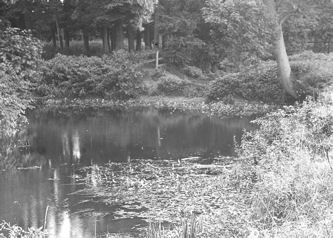W.E. Dring, 1974
This is the third part of a series of reminiscences of Trumpington in the 1920s. For an introduction to the series, see Trumpington Fifty Years Ago: Reminiscences of the 1920s.
Grantchester Road, Byron’s Pool and the River Cam

Past the school the lane wanders on down by the church which contains the tomb and brass of Sir Roger de Trumpington, the Crusader, the second oldest brass in England. On the right lie the woods and park of Trumpington Hall, owned for many years by the Pemberton family. Mrs Pemberton (Viola Pemberton), the grand old lady of the manor, lived in part of it until she died recently, and her son (Francis Pemberton) is well-known in connection with the Royal Show. The Women’s Institute and many other associations owe much to Mrs. Pemberton’s drive and organisational powers in the past.
The lane continues on down the hill to the river and Brazel Bridge (Brasley Bridge), with the entrance to the woods on the left. This path leads eventually to Byron’s Pool where the poet is reputed to have bathed when up at Cambridge. On the way up to the Pool is a deep part of the river with an evil reputation for drowning bathers and is known as Dead Man’s Hole. The river here divides Trumpington from Grantchester and as the burial of unknown bodies in the early days was a charge on the parish, any bodies found by Trumpington men were hastily transferred to the Grantchester side of the river and vice-versa.
Above the old mill pool once stood the mill where Chaucer’s Miller of Trompyngtone made famous in the Reeve’s Tale. The foundations of the mill are still visible when the water is low and in high summer we used to wade out and stand on the masses of sunken brickwork and fish for gudgeons. The pool was also used as a swimming bath and some of the local lads and men who had no bath facilities at home used to soap themselves all over and then dive in from the sluice gate wall. Beyond the sluice the woods were thick and tangled and in the middle lay three old and gloomy fishponds tangled with fallen trees. A little further on the trees thinned out and close alongside the path was what was called the Lovers’ Seat, a fallen tree, still growing, which had sent up three vertical branches to form the back and sides of a natural seat. On the other side of the river lay Lingay Fen, which in winter was flooded and used for skating. The contests for the Championship of England were held here for a number of years.
Beyond the woods, the river meandered through open water meadows where cattle pastured, down to the Pile Bridge where the railway crossed the river, on to the osier beds, a favourite spot for eel fishermen to drop in their night lines. I have had many a dish of stewed eels caught in this way by my father. Punts and canoes from Cambridge sometimes penetrated as far as this, some playing music on portable gramophones, without somehow spoiling the peace of the river as modern transistor sets do. Perhaps popular music in those days was more melodious!
From Byron’s Pool, a branch of the river ran down to Grantchester Mill. The lane also ran down to it from Brazel Bridge, between white posts. These were placed there to indicate the road when it was flooded in winter. A house now stands on the site of the mill, which I remember was burned down before the Second World War. Just beyond the mill pool is the old Vicarage where another poet, Rupert Brooke, lived. He was killed in the First World War and his ghost is reputed to still haunt the place. His famous poem Grantchester which describes the village, was written while he lived at the Vicarage. “His ghostly Lordship” may still swim the pool, but the church clock no longer “stands at ten to three”.
Continue with the next part of W.E. Dring’s reminiscences of Trumpington in the 1920s.